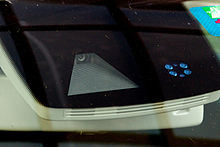Lane departure warning
The lane departure warning (including lane departure warning , Eng. Lane departure warning system (LDW) for lane departure warning and lane keeping assist for the active lane assistant with steering assistance) is a driver assistance system , which the driver of a vehicle before leaving the lane warning on a street. Different optical systems and computers are used to determine the position of the vehicle in the lane. The system warns if the distance to the lane markings is not reached ( Distance-to-Line-Crossing -criterion (DLC)) and can calculate this shortfall with the help of the Time-to-Line-Crossing -criterion (TLC).
Lane departure warning (without steering assistance)
LDWS - Lane Departure Warning System
The LDWS lane departure warning system used by some manufacturers is integrated in a dashcam . It is used to record car journeys on video . It also enables an inexpensive retrofit variant of an LDWS and FCWS system (English Front Collision Warning System) for older vehicles. The LDWS system itself is based on image processing technology. The position of the vehicle in relation to the lane markings is continuously calculated and monitored. If the lane markings are crossed, the driver is warned acoustically via an advisory tone or a voice announcement. The lane markings can be recognized despite an interruption in the marking.
AFIL - lane deviation alert through infrared line detection
In the AFIL system from system manufacturer Valeo , infrared sensors are attached to the underbody of the vehicle. The warning occurs on the relevant side of the driver's seat through the use of two vibration motors. To do this, the indicators must not be active and the vehicle speed must not be less than 70 km / h. Such a system is available for Citroën C4 , Citroën C5 and Citroën C6 .
Active lane departure warning system (with steering assistance)
LKAS - Lane Keep Assist System
The active lane departure warning system determines the lane using a CMOS camera mounted behind the windshield . From the captured images, it then determines the optimal steering angle to keep the vehicle in the middle of the lane. If the vehicle is about to drive over the lane markings, a warning beep or a rattling noise is emitted or the steering wheel is vibrated. To do this, the following conditions must be met:
- The driver is in contact with the steering wheel
- Turn signals are not active
- the steering movement exerted by the driver does not indicate a change of lane
If the system detects that the driver has taken their hands off the steering wheel, it switches itself off completely after a warning.
The first production vehicle in which the system was available is the Nissan Cima , on the Japanese market from 2001 with Lane Keeping Assist (LKAS).
Other systems
Most systems from different manufacturers have a small camera installed behind the windshield (the usual position for the rain sensor ). This recognizes lane boundaries as well as unpaved roadsides on secondary roads.
Lane keeping support
The lane keeping support (English: support lane keeping , heading control ) supports the driver by automatically permanent co-steering while tracking. See also: traffic jam assistant , motorway pilot .
literature
- Karl-Heinz Dietsche, Thomas Jäger, Robert Bosch GmbH: Automotive pocket book. 25th edition, Friedr. Vieweg & Sohn Verlag, Wiesbaden 2003, ISBN 3-528-23876-3 .
Individual evidence
- ↑ Best co-driver. German Road Safety Council, accessed on May 10, 2017 .
- ^ Nissan Demos New Lane Keeping Products ( Memento from January 10, 2005 in the Internet Archive )

